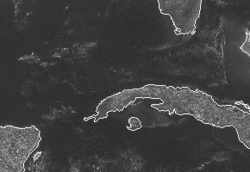- Sea breeze
-
For other uses, see Sea Breeze (disambiguation) and Bay breeze (disambiguation).
A sea-breeze (or onshore breeze) is a wind from the sea that develops over land near coasts. It is formed by increasing temperature differences between the land and water; these create a pressure minimum over the land due to its relative warmth, and forces higher pressure, cooler air from the sea to move inland. Generally, air temperature gets cooler relative to nearby locations as one moves closer to a large body of water.[1]
Contents
Main cause
The sea has a greater heat capacity than land and therefore is more able to absorb heat than the land, so the surface of the sea warms up slower than the land's surface.[2] As the temperature of the surface of the land rises, the land heats the air above it. The warm air is less dense and so it rises. This rising air over the land lowers the sea level pressure by about 0.2%. The cooler air above the sea, now with higher sea level pressure, flows towards the land into the lower pressure, creating a cooler breeze near the coast. The strength of the sea breeze is directly proportional to the temperature difference between the land and the sea. If the environmental wind field is greater than 8 knots and opposing the direction of a possible sea breeze, the sea breeze is not likely to develop.[3]
Effects
A sea-breeze front is a weather front created by a sea-breeze, also known as a convergence zone. The cold air from the sea meets the warmer air from the land and creates a boundary like a shallow cold front. When powerful this front creates cumulus clouds, and if the air is humid and unstable, cumulonimbus clouds, the front can sometimes trigger thunderstorms. If the flow aloft is aligned with the direction of the sea breeze, places experiencing the sea breeze frontal passage will be benign, or fair, weather for the remainder of the day. At the front warm air continues to flow upward and cold air continually moves in to replace it and so the front moves progressively inland. Its speed depends on whether it is assisted or hampered by the prevailing wind, and the strength of the thermal contrast between land and sea. At night, the sea-breeze usually vanishes.
Sea-breezes in Florida
Thunderstorms caused by powerful sea breeze fronts frequently occur in Florida, a peninsula surrounded on both the east and west by the Atlantic Ocean and Gulf of Mexico, respectively. No matter which direction the winds are blowing, they are always off the water, thus making Florida the place most often struck by lightning in the United States, and one of the most on Earth. [4] These storms also can produce significant hail due to the tremendous uplift it causes in the atmosphere especially during times when the upper atmosphere is cooler such as during the spring or fall.
On calm summer afternoons with little prevailing wind, sea-breezes from both coasts may collide in the middle, creating especially severe storms down the center of the state. These thunderstorms can drift towards either the west or east coast depending on the relative strengths of the sea-breezes, and sometimes survive to move out over the water at night, creating spectacular cloud-to-cloud lightning shows for hours after sunset. [5][6]
Land breezes
At night, the land cools off quicker than the ocean due to differences in their heat capacity, which forces the dying of the daytime sea breeze. If the land cools below that of the adjacent sea surface temperature, the pressure over the water will be lower than that of the land, setting up a land breeze as long as the environmental surface wind pattern is not strong enough to oppose it. If there is sufficient moisture and instability available, the land breeze can cause showers or even thunderstorms, over the water. Overnight thunderstorm development offshore due to the land breeze can be a good predictor for the activity on land the following day, as long as there are no expected changes to the weather pattern over the following 12–24 hours. This is mainly because the strength of the land breeze is weaker than the sea breeze.[3] The land breeze will die once the land warms up again the next morning.
See also
- Fremantle Doctor, the local name for the sea breeze in and around Perth, Western Australia
- Mountain breeze and valley breeze
References
- ^ Reynolds, Wenke, Esterguard (2005) "Project OINTMENT -- Ontario's Impact Nipping Towards Markdowns with Environmental Naturalization of Temperatures"
- ^ University of Wisconsin. Sea and Land Breezes. Retrieved on 2006-10-24.
- ^ a b JetStream: An Online School For Weather (2008). The Sea Breeze. National Weather Service. Retrieved on 2006-10-24.
- ^ Lightning Research Laboratory (UF). Lightning.ece.ufl.edu. Retrieved on 2009-02-06.
- ^ Winsberg, Morton (2003). Florida Weather. Gainesville: University Press of Florida. ISBN 0813026849.
- ^ Henry, James (1998). The Climate and Weather of Florida. Sarasota, Florida: Pineapple Press (FL). ISBN 1561640360.
External links
Categories:- Marine meteorology and sailing
- Wind
Wikimedia Foundation. 2010.




